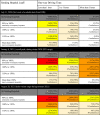Ambulances Required to Relieve Overcapacity Hospitals: A Novel Measure of Hospital Strain During the COVID-19 Pandemic in the United States
- PMID: 35940995
- PMCID: PMC9356618
- DOI: 10.1016/j.annemergmed.2022.05.036
Ambulances Required to Relieve Overcapacity Hospitals: A Novel Measure of Hospital Strain During the COVID-19 Pandemic in the United States
Abstract
Study objective: One in 4 deaths from COVID-19 has been attributed to hospital crowding. We simulated how many ambulances would be required to rebalance hospital load through systematic interhospital transfers. We assessed the potential feasibility of such a strategy and explored whether transfer requirement was a helpful measure and visualization of regional hospital crowding during COVID-19 surges.
Methods: Using data from the United States hospitals reporting occupancy to the Department of Health and Human Services from July 2020 to March 2022 and road network driving times, we estimated the number of ambulances required weekly to relieve overcapacity hospitals.
Results: During the peak week, which ended on January 8, 2021, approximately 1,563 ambulances would be needed for 15,389 simulated patient transports, of which 6,530 (42%) transports involved a 1-way driving time of more than 3 hours. Transfer demands were dramatically lower during most other weeks, with the median week requiring only 134 ambulances (interquartile range, 84 to 295) and involving only 116 transports with 1-way driving times above 3 hours (interquartile range, 4 to 548). On average, receiving hospitals were larger and located in more rural areas than sending hospitals.
Conclusion: This simulation demonstrated that for most weeks during the pandemic, ambulance availability and bed capacity were unlikely to have been the main impediments to rebalancing hospital loads. Our metric provided an immediately available and much more complete measure of hospital system strain than counts of hospital admissions alone.
Copyright © 2022 American College of Emergency Physicians. Published by Elsevier Inc. All rights reserved.
Figures






Comment in
-
Response to "Ambulances Required to Relieve Overcapacity Hospitals: A Novel Measure of Hospital Strain during the COVID-19 Pandemic in the United States".Ann Emerg Med. 2023 May;81(5):644-645. doi: 10.1016/j.annemergmed.2022.12.030. Ann Emerg Med. 2023. PMID: 37085207 Free PMC article. No abstract available.
Similar articles
-
Response to "Ambulances Required to Relieve Overcapacity Hospitals: A Novel Measure of Hospital Strain during the COVID-19 Pandemic in the United States".Ann Emerg Med. 2023 May;81(5):644-645. doi: 10.1016/j.annemergmed.2022.12.030. Ann Emerg Med. 2023. PMID: 37085207 Free PMC article. No abstract available.
-
Burden of hospital admissions and resulting patient interhospital transports during the 2020/2021 SARS-CoV-2 pandemic in Saxony, Germany.Sci Rep. 2023 May 24;13(1):8407. doi: 10.1038/s41598-023-35406-y. Sci Rep. 2023. PMID: 37225747 Free PMC article.
-
Effectiveness of Hospital Ambulance Utilization in a Community-Based Integrated Care System.Cureus. 2025 May 8;17(5):e83754. doi: 10.7759/cureus.83754. eCollection 2025 May. Cureus. 2025. PMID: 40486480 Free PMC article.
-
Pandemic hospitals and reorganizing emergency departments.Turk J Med Sci. 2021 Dec 17;51(SI-1):3221-3228. doi: 10.3906/sag-2106-169. Turk J Med Sci. 2021. PMID: 34284534 Free PMC article. Review.
-
Managing emergency department overcrowding.Emerg Med Clin North Am. 2009 Nov;27(4):593-603, viii. doi: 10.1016/j.emc.2009.07.004. Emerg Med Clin North Am. 2009. PMID: 19932394 Review.
Cited by
-
Response to "Ambulances Required to Relieve Overcapacity Hospitals: A Novel Measure of Hospital Strain during the COVID-19 Pandemic in the United States".Ann Emerg Med. 2023 May;81(5):644-645. doi: 10.1016/j.annemergmed.2022.12.030. Ann Emerg Med. 2023. PMID: 37085207 Free PMC article. No abstract available.
-
Decreasing length of stay in breast reconstruction patients: A national analysis of 2019-2020.J Surg Oncol. 2023 Oct;128(5):726-742. doi: 10.1002/jso.27378. Epub 2023 Jul 5. J Surg Oncol. 2023. PMID: 37403585 Free PMC article.
-
Structural and social changes due to the COVID-19 pandemic and their impact on engagement in substance use disorder treatment services: a qualitative study among people with a recent history of injection drug use in Baltimore, Maryland.Harm Reduct J. 2024 May 8;21(1):91. doi: 10.1186/s12954-024-01008-8. Harm Reduct J. 2024. PMID: 38720307 Free PMC article.
-
Application of exponential smoothing method and SARIMA model in predicting the number of admissions in a third-class hospital in Zhejiang Province.BMC Public Health. 2023 Nov 22;23(1):2309. doi: 10.1186/s12889-023-17218-x. BMC Public Health. 2023. PMID: 37993836 Free PMC article.
-
Trends in Patient Transfers From Overall and Caseload-Strained US Hospitals During the COVID-19 Pandemic.JAMA Netw Open. 2024 Feb 5;7(2):e2356174. doi: 10.1001/jamanetworkopen.2023.56174. JAMA Netw Open. 2024. PMID: 38358739 Free PMC article.

